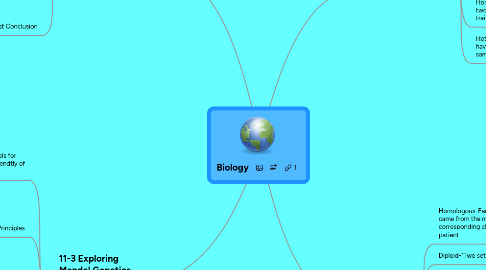Biology
por Zachary Herr


1. 11-1 Work of Gregor Mendel
1.1. Trait=Characterisitc
1.1.1. Seed shape ,seed color, plant height
1.2. Gene=Part of DNA coding for trait
1.3. Allele=2 Contrasting forms of gene
1.4. Gregor Mendel & Pea Plants
1.4.1. 7 Traits each with contrasting alleles
1.4.2. Self Pollination vs Cross Pollination
1.5. Mendels First Conclusion
1.5.1. Law of Dominance
1.5.1.1. Capital Letter=Dominant
1.5.1.2. Lowercase Letter=Recessive
2. 11-3 Exploring Mendel Genetics
2.1. Independent assortment-allels for seed shape segerated independtly of those for seed color
2.1.1. Mendels results were very close to the 9:3:3:1 ratio
2.2. Mendels Principles
2.2.1. Biological characteristics are determined by genes
2.2.2. Some parts may be dominant others may be recessive
2.2.3. Allels usually seperate independently
2.3. Incomplete Dominance-One allele is not completlt domaint over another
2.4. Codominance-Both allels contribute to the phenotype
2.5. Multiple Alleles-Genes that have more than two alleles
3. 11-2 Probablity & Punnett Squares
3.1. Probability=Liklihood that a particular event will occur
3.1.1. Coin toss
3.2. Punnett Squares=Gene combination that might result from a genetic cross can be determined by drawing a diagram
3.2.1. Letters in the Punnett square represent alleles
3.3. Punnett squares are used to predict and compare the genetic variables that will result from a cross
3.4. Homozygous-organisms that have two identical alles for the same trait
3.5. Heterozygous-Organisms that have two different alles for the same trait
4. 11-4 Meosis
4.1. Homologous-Each of the 4 chromosomes that came from the male patient has a corresponding chromosome from the female patient
4.2. Diploid-"Two sets"
4.3. Crossing over-exchange portions of their chromatids
4.4. The difference between mitosis and meiosis
4.4.1. Mitosis results in the prodtuction of two genetically identicall diploid cells
4.4.2. Meiosis produces four gentically different haploid cells
